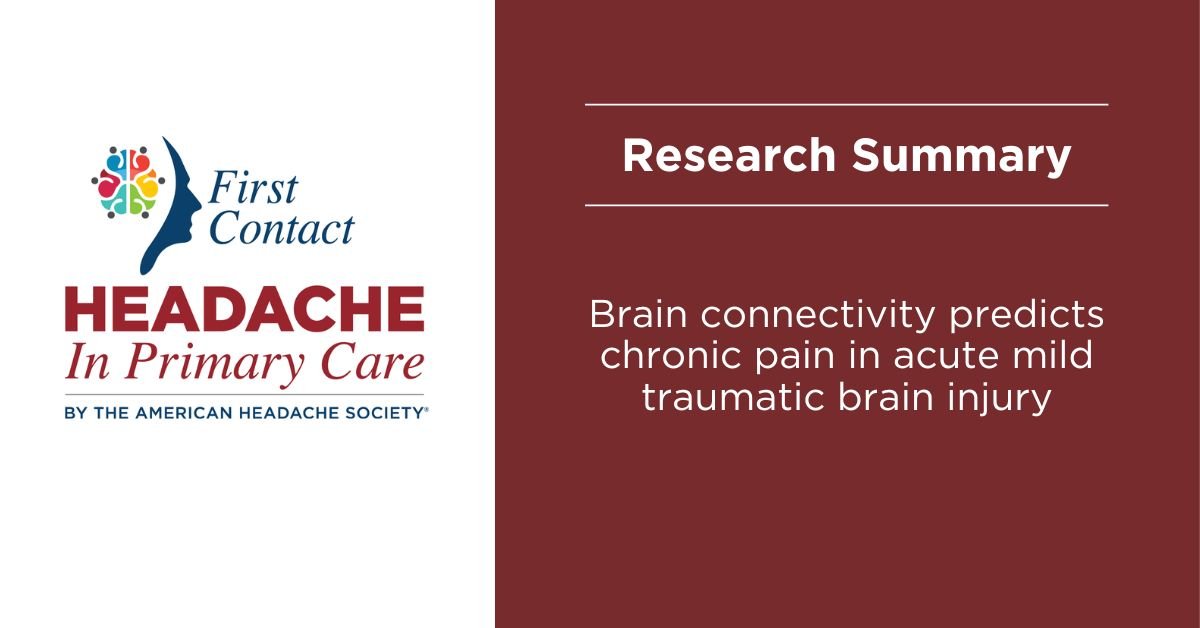
Research Summary: Brain connectivity predicts chronic pain in acute mild traumatic brain injury
Summarized by Tracy Grossman, MD, MSc
Chronic pain prediction is a tool primary care practitioners can use to stage early preventive interventions. Mild traumatic brain injury is an acute pain model where chronic pain is prevalent and complicated for prediction, hampering early preventive interventions. A recent study shows the correlation between functional connectivity of the nucleus accumbens and mild traumatic brain injury, highlighting a potential predictive biomarker to reconcile these issues.
This month, the First Contact – Headache in Primary Care team summarized Brain connectivity predicts chronic pain in acute mild traumatic brain injury.
Study Overview
- Brain structures within the cortico-mesolimbic system, such as the nucleus accumbens (NAc) and periaqueductal gray matter (PAG), have been recognized to play a role in chronic pain.
- The transition from acute to chronic pain, and what factors may predict this transition, is largely unknown.
- Mild traumatic brain injury (mTBI) may represent a model wherein chronic pain following acute painful injury is prevalent, yet prediction of progression from acute to chronic pain remains complicated.
- This study aimed to examine whether functional connectivity (FC) of the NAc and PAG is predictive of pain chronification in early-acute mTBI.
Study Methods
- Participants were included if they had a motor vehicle induced direct or indirect head and neck injury within 24 hours preceding emergency department presentation and met criteria for mTBI.
- Resting-state functional MRI (rs-fMRI) of 105 participants with mTBI was acquired within 72 hours post-injury in order to estimate the FC of the NAc and the PAG.
- Participants were classified into chronic pain and recovery groups according to pain ratings provided at 12-months post-collision, and their FC maps were compared.
Study Results
- One hundred five participants were included in the study, with most of them reporting indirect head injury (74, 70.5%).
- Forty-four (41.9%) participants were classified in the chronic pain group at the 12-month endpoint, with 61 (58.1%) participants in the recovery group. Those in the chronic pain group had significantly higher baseline pain ratings compared with the recovery group.
- Periaqueductal Gray Matter and Nucleus Accumbens Functional Connectivity:
- Whole brain analysis in relation to NA:
- Both groups had positive correlation of whole-brain FC parametric maps for right NAc.
- There was an increase in FC in pre-central gyrus clusters in the chronic pain group compared to recovery group.
- Whole brain analysis in relation to PAG:
- Whole brain analysis was consistent with an increase in FC in the post-central gyrus clusters for the chronic pain group relative to the recovery group.
- There was an overall weaker negative FC correlation in the chronic pain group.
- Whole brain analysis in relation to NA:
- Correspondence of Increased FC to a Somatotopic Division of the Sensorimotor Cortex and Additional Analyses:
- NA: projections of increased FC in chronic pain mapped to the bilateral border area between the primary motor region of the upper limb and lips.
- PAG: the same projections mapped to the bilateral primary somatosensory region trunk.
- Additional network-level analyses suggest specificity to the mesolimbic, descending pain modulation, and sensorimotor systems, including a shared thalamic involvement.
- Brain connectivity showed high classification accuracy for future chronic pain when combined with an acute pain intensity report.
- Qualitative Data Pre-pandemic:
- Patients found telehealth appealing because they could attend appointments without disruption to daily responsibilities while also avoiding long travel times.
- Telehealth was especially appealing for those with physical limitations and who felt attending in-person appointments triggered headache attacks.
- Providers deemed telehealth appropriate for monitoring and adjusting pharmacotherapy and reviewing side effects of medications, as well as for behavioral treatments.
- Providers felt telehealth was beneficial for patients in rural areas or with rare headache disorders who have limited access to specialists.
- Psychological and Psychophysical Correlates of Functional Connectivity:
- Another goal was to identify clinical correlates of the functional link most significantly associated with the chronic pain outcome.
- The correlation coefficients between NAc-Pre-central gyrus FC and pain-related psychological and psychophysical parameters collected at the same baseline session revealed functional links to:
- Pain sensitivity questionnaire score (r= 0.269, FDR-corrected p = 0.045)
- The temperature necessary to induce a heat-pain rating of 50 in °C (r= −0.242, FDR-corrected p = 0.045)
Implications for Primary Care Clinicians
- Individuals who eventually develop chronic pain following mTBI may be differentiated from the ones who recover well in the very early-acute stage based on connectivity of the sensorimotor system and PAG and NAc.
- The use of early pain interventions in this subset of patients who are at higher risk for developing debilitating chronic pain should be considered.
This summary is part of the First Contact — Headache in Primary Care initiative, an American Headache Society program that provides educational resources to empower healthcare professionals and improve headache and migraine care. We encourage providers in all stages of their careers to visit our homepage to access educational tools to improve patient care.


